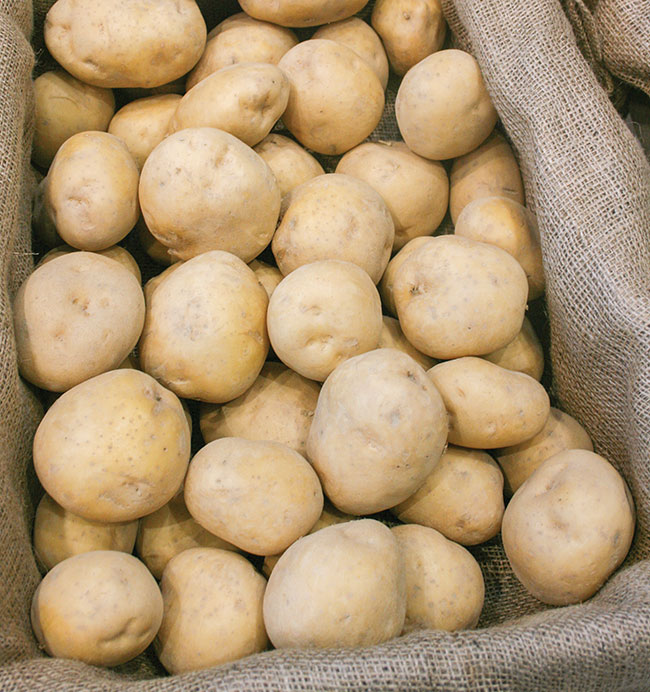
Features
Fertility and Nutrients
Small and mighty: Micronutrients in potatoes
Micronutrients are key for potato.
February 27, 2020 By Julienne Isaacs
 “Biofortified” potatoes rich in micronutrients like iron, zinc, and copper help promote human nutrition. Photo by Potatoes in Canada.
“Biofortified” potatoes rich in micronutrients like iron, zinc, and copper help promote human nutrition. Photo by Potatoes in Canada. The big picture macronutrient requirements of most field crops are well known. Producers might be less familiar with the smaller micronutrient requirements, for one good reason: normally, soils carry enough micronutrients without needing amendments. In the case of potato, a few key micronutrients make a big difference to yield and quality. If they’re deficient, you’ll see problems.
Macronutrients are required in relatively large amounts to keep crops thriving and include nitrogen, phosphorus, potassium, calcium, magnesium and sulfur. Micronutrients – named because plants need them in much smaller, or “micro,” quantities, and not because they’re less essential – include boron, copper, iron, manganese, zinc, nickel, molybdenum and chloride.
For potatoes, the micronutrients researchers are most concerned with are boron and zinc, says Umesh Gupta, research scientist emeritus with Agriculture and Agri-Food Canada in Charlottetown.
“If there’s not enough boron in the soil but the potato is growing rapidly, it’s susceptible to hollow heart,” Gupta says.
Hollow heart, easily identifiable by a star-shaped cavity in the middle of the tuber, is more common in rutabaga or turnip, but when it affects potatoes it significantly impacts quality.
Boron application can be very helpful for potato soils in regions with sandier soils, says Joann Whalen, a professor in the department of Natural Resource Sciences at McGill University. She’s seen reports of boron deficiencies in Australia, the United States and throughout Atlantic Canada.
Zinc is also key for potatoes: the mineral helps with photosynthesis and cell growth and serves as a binding agent in enzyme reactions. If it’s deficient, potato growth is stunted.
Whalen says a study from Iran showed that zinc deficiency in potato caused a reduction in tuber weight as well as the number of tubers per plant.
“If you’re observing some type of unexplained small reduction in the number of tubers per plant, it could be good to attend to zinc concentration in the soil, and follow up with a petiole analysis,” Whalen says.
Petiole or leaf stem analyses should typically be conducted every seven to 10 days during the growing season. “The nutrient requirements change as the plant develops,” Whalen explains. “There are different demands all through the growing season.”
Application rates
Carl Rosen, professor and head of the department of soil, water, and climate at the University of Minnesota, says even when boron levels are low, adding the mineral might not result in a yield response, although in some trials it does increase tuber size profile.
Response to other micronutrients depends on the soil, he says. For example, manganese and iron might be deficient on high pH soils, while copper and manganese might be low on organic soils.
For example, manganese and iron might be deficient on high pH soils, while copper and manganese might be low on organic soils.
“Have soil tested for micronutrients and pH before planting; during the growing season, sample petioles and have them tested,” he says.
Micronutrients are not mobile in the plant, so symptoms of deficiency appear on the younger leaves first then spread to lower leaves in severe cases.
But while producers should be on the alert for micronutrient deficiencies in the crop, they should be careful not to over-correct if a soil or petiole test shows levels are low.
But while producers should be on the alert for micronutrient deficiencies in the crop, they should be careful not to over-correct if a soil or petiole test shows levels are low.
Overapplication of boron can result in toxicity, impacting yields.
For boron, recommendations are usually one to two pounds per acre; toxicity can result if boron is applied at 10 pounds per acre, with cupping of leaves and sometimes necrosis of the leaf margins, Rosen says.
Boron is commonly available in North America through a company called 20 Mule Team that produces solid borax as well as a soluble version called Solubor. As a foliar spray the product should be applied before flowering or tuber formation, Whalen says; it can be applied with an adjuvant that aids absorption through the leaves.
According to Gupta, plant health is only one reason producers should keep their eye on the micronutrient requirements of their potato crop: micronutrients are also key for human health.
Micronutrients are also key for human health.
“Biofortified” potatoes rich in micronutrients like iron, zinc and copper help promote human nutrition.
Three decades ago, boron was not considered essential for human health, but now it’s been linked to memory, cognitive function and bone strength. Zinc helps activate enzymes that remove free radicals and limit oxidative stress.
Optimal quality and yields are typically considered the chief goal for potato production, but Gupta says human health needs to stay on the agenda. “We have to remember potatoes are consumed by humans. They should contain sufficient nutrients so people are getting them in their diet,” he says.
Print this page